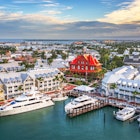
Dec 26, 2025 • 7 min read
Finding the bargains amid Key West's quaint, touristed streets can be tough. Still, a visit to this wonderful place doesn't have to light your budget on fire.

Dec 26, 2025 • 7 min read
Finding the bargains amid Key West's quaint, touristed streets can be tough. Still, a visit to this wonderful place doesn't have to light your budget on fire.

Dec 26, 2025 • 8 min read
Fabulous beaches, storied cities, rural retreats and Europe’s largest volcano: Sicily has it all. Here’s where to go (and stay) on this storied island.

Dec 25, 2025 • 6 min read
Like the mythical Sirens tempting sailors, Greece lures travelers to its scintillating shores. Dream up an ideal Greece itinerary to these 10 locales.

Dec 25, 2025 • 4 min read
Belize is where Latin-flavored Central America meets the captivating culture of the Caribbean. Here's how you can choose the perfect time to visit.

Dec 25, 2025 • 8 min read
Before you set off for dreamy Greece, read our tips to help you with planning your trip, and navigating the country once you arrive.

Dec 24, 2025 • 7 min read
Known for its natural beauty, specialty ramen and outdoor adventures, Hokkaidō is a relaxed, laid-back and totally captivating Japanese destination.

Dec 24, 2025 • 10 min read
From Paris to Provence, make the most of your time exploring France's many delights with our pick of the top places to see.

Dec 23, 2025 • 7 min read
Beyond the obvious towns of Lisbon and Porto, Portugal promises vibrant historic cities, incredible beaches and wonderful wine regions.

Dec 23, 2025 • 8 min read
Two Lonely Planet writers go head-to-head, debating which Spanish island is better: Mallorca or Ibiza.

Dec 23, 2025 • 3 min read
When the winter blues hit, the cure lay in volcanic landscapes, sea air and sunrise beach yoga on the quieter side of the Canaries.

Dec 23, 2025 • 8 min read
Inside Tunisia’s compact borders, you’ll find everything you could ask for from the southern Mediterranean. Here are the best times to visit Tunisia.

Dec 23, 2025 • 13 min read
The fortunes of the Egyptian city of Alexandria have always been tied to its strategic location at the mouth of the Nile. Here are the top things to do.

Dec 23, 2025 • 8 min read
Cuba can confuse even veteran travelers. Get answers to your money questions and find out whether those bargain cigars are worth it in this no-fail guide.

Dec 23, 2025 • 5 min read
The Dominican Republic lines up glorious beaches all along its Atlantic and Caribbean coastline. These 8 are among the very best.

Dec 22, 2025 • 10 min read
The deserts of Egypt may seem barren – but below the water, it’s a different story. Here are the best places to dive and snorkel in Egypt.

Dec 22, 2025 • 12 min read
There's more to Delphi than ancient ruins: make time to hike in the hills, visit neighboring villages, drive the coast and sip coffee overlooking the sea.

Dec 22, 2025 • 6 min read
From trains and car hire to ferries and taxi boats, plan your travels in Sicily with this guide to transportation.

Dec 22, 2025 • 10 min read
Tucked between the Sahara and the Med, Tunisia packs a lot of wonders into its compact territory. Here's everything you need to know about getting around.

Dec 22, 2025 • 11 min read
Plan your family travels in Japan with this guide to the best experiences that kids will love.

Dec 22, 2025 • 6 min read
This gem in the Florida Keys offers a winning mix of nature, culture and rum cocktails. These are the best things to do in Islamorada.

Dec 22, 2025 • 7 min read
Cairo, the original city that never sleeps, is at the epicenter of the action in Egypt. Here are the best things to do there.

Dec 22, 2025 • 5 min read
Exhibitions at US museums in 2026 will highlight Impressionist works, showcase Renaissance masters and celebrate American art.